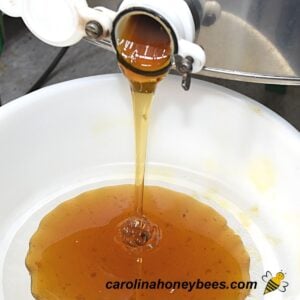
Extract Honey From a Hive
Separating your honey harvest from the comb can be accomplished in several ways. The fastest and easiest is with the use of a machine called a honey extractor.
This post may contain affiliate links. As an Amazon Associate, I earn from qualifying purchases.
Read my Disclosure.Tools
- Honey Extractor (Electric or Hand Crank)
- Electric Knife (or hot bread knife)
Supplies
Instructions
- Uncapping Honey FramesThe first step in extracting honey with a machine is uncapping. When honey is ripe, bees cap each cell with a clean wax cap. This helps keep the honey clean and protected. Before we can extract the liquid, the cap must come off. The goal is to break open or slice off the wax cappings without digging into the comb any more than you can help. Catch the cappings in a bucket. They will contain a large amount of liquid if allowed to drain. Also, cappings wax is the one of the best types of beeswax to use for candles and other projects.

- Load Uncapped Frames in ExtractorAs you uncap each frame (both sides) place it directly into the extractor. Depending on the size of your extractor you may need 4 frames, 9 or even more for a full load. If you do not balance your load, the uneven weight will cause the extractor to move. Much like Granny’s old washing machine walking across the floor. So don’t try to do a partial load in the extractor unless you position the frames evenly to distribute weight.

- Place the Catch Bucket and StrainerOnce the extractor is full of frames, you are ready to begin the process of extraction. You will have a “honey gate” spout at the bottom of the unit. This is where the liquid pours out of the extractor.Most beekeepers use a 3 or 5 gallon bucket as the storage pail, with a “bucket filter or bag” placed inside. No matter how hard you try to be careful, some pieces of beeswax will come out in the liquid honey. This strainer allows gravity to filter out the beeswax chunks etc. Of course with the strainer in place, you can not fill the bucket to the top with honey. Keep that in mind as you extract – have extra buckets. A 5 gallon bucket of honey is HEAVY! It’s okay to fill it only partially. As long as you have a tight fitting lid your honey will be fine and your back with thank you for it.

- Start the ExtractorStart the extractor spinning. Go slow – this is not a race. Especially with an electric extractor the temptation is to crank that thing up. Resist the urge.You are more likely to have your extractor walking across the floor or even damaged if you start off at top speed. This applies to hand crank models as well. Beginning too fast can use cause weak honeycomb to be thrown out of your frames. Start slow, gradually increase the speed.

- Increasing Extractor SpeedWhether using an electric or hand extractor - begin slowly. If you begin too fast, the machine is more likely to bounce around.You will notice (and hear) drops of honey and wax hitting the inside of the extractor wall as honey is thrown from the uncapped frames. Do not insert hands or any other body parts or items inside the running extractor !!!Slowly increase the speed and continue until no more honey is coming off the frames. You will likely never need to get your machine up to top speed - you may damage your comb.Honey will begin to flow from the gate at the bottom into your filter and catch bucket.

- Remove Empty FramesRemove the finished frames from the extractor. They will be very sticky but the cells should be empty of honey. If I missed a few in the uncapping process, I don’t worry. I just leave it for the bees. If you missed a large area you can put it through the extractor again but be sure to balance the weight in the machine.Special Note: Depending on the type of extractor you have - you may have to flip the frame over and do the other side.

- Cleaning Wet FramesPlace the frames back in the super boxes. These frames of drawn comb are valuable. If you have a long honey season, they can be put back on the hives and reused. If not, they will give the bees a head start next year.

- Storing Your HarvestAfter all of the honey has dripped through your bucket filter, there may be a little foam on top. That is okay. Let the honey settle a few days - then use a spatula or large spoon to skim it off.Be sure to seal the bucket with a good lid. Honey will last forever but it absorbs moisture from the air. Failure to seal the bucket could result in your entire bucket spoiling.

Notes
Extraction Tips:
For uncapping you can use an electric honey knife, a large bread knife that has been heated in hot water and wiped dry or the uncapping scrapper. They all do the same job.
How long the process takes depending on your technique, the viscosity of your local honey and the temperature in the room.
You must be in a bee-tight location or those little girls will try to take the honey back!
Learn more about bees and using products from the hive!Join me on Pinterest - @carolinahoneyb